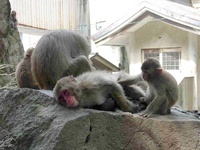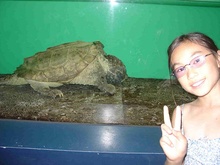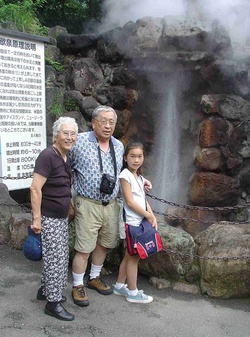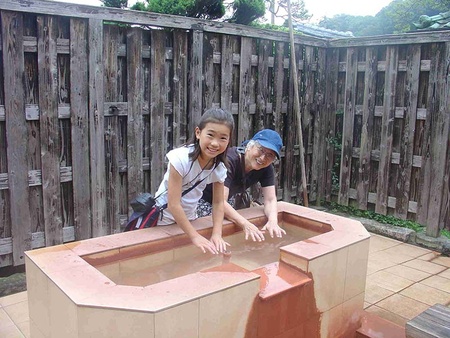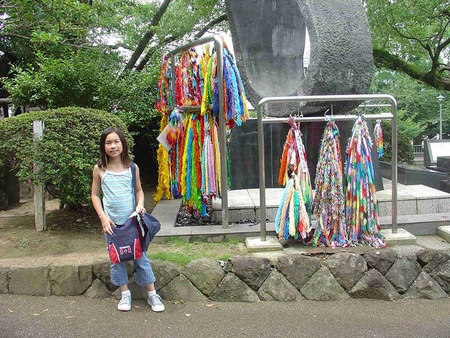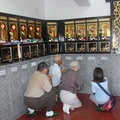Editor’s Note: This series of articles is taken from a diary kept by Nikkei Canadian Alyssa Erin Woo, then ten years old, during her trip to Japan with her grandparents.
Part 6 >>
Tuesday, July 12, 2005 – Beppu
Today, we went to Beppu. On our way, we stopped at Joyfull for lunch. Again, I had my favourite meal: Spaghetti! Joyfull was becoming the new Denny’s!
When we got to Beppu, we went to see the monkeys. When Mom went, there were only 200 monkeys and she thought that many was a lot. But now, there are over 700! I got really close to them but people aren’t supposed to look them in the eye because they might attack us. When the man who feeds the monkeys called them, the monkeys went rushing to him for food. When you look at them all they look like a huge brown blob making noises for their lunch. I have never seen so many monkeys before in my life.
These tamed monkeys live in a natural environment and they were fun to watch playing together. Some mother monkeys were feeding the little ones.
Then we went to Marine Palace. I saw all kinds of interesting fish and some were from the Pacific Ocean! There were also sharks, jellyfish, octopus, seals, otters, walrus, whales, sting rays and a lot more. There was a shop too, and we bought souvenirs.
We stayed at a Japanese style hotel. Everyone liked the fancy Kaiseki dinner but I enjoyed the hamburger and chicken instead.
We went into the hot spring bath and had fun. I even swam there.
When we got out, we couldn’t find the key and went upstairs to see if Ji-chan was there, but when I knocked, he didn’t answer. The second time, he said “Who’s there” in a low voice and I thought I had the wrong room number but then he told me he took the key from the ladies hot bath room as he was locked out when he came back to the room.
* * *
Wednesday, July 13, 2005 – Beppu and Nagasaki
Katsumi-san and Yoshiko-san took us all to see the Jigokus (meaning hell). We saw a reddish Jigoku hot spring. There was a lot of steam coming from it. Ba-chan and I dipped our hands in the hot water and it healed our skin (I had lots of mosquito bites!)
Then we went to see another Jigoku, which shoots up in the air about every 30-45 minutes and lasts 6-10 minutes. We waited for about 1 hour before it shot up.
It was really cool to see. It shot up really fast and lasted about 10 minutes.
After we said good-bye to other relatives who came with us, we took a long train ride from Beppu to Nagasaki (atomic bombed city during the Second World War.) We went to a department store and had KFC for lunch and it was delicious. I haven’t had it in a long time. Then, we went to look around and found a grocery store and we brought some food back to the Hotel New Nagasaki where we stayed.
Ba-chan and Ji-chan fell asleep so I decided to surprise them with a fancy dinner table with whatever was available in the room. Also, I liked going to get ice for us.
When they woke up, they were surprised to see my neatly arranged table. I liked this hotel a lot except children aren’t allowed in the swimming pool! But, adults wouldn’t want to swim there anyway because they charge ¥5,000 to use the pool! After dinner we were all tired and fell asleep.
* * *
Thursday, July 14, 2005 – Hakata, Fukuoka
After we checked out of the hotel, we went to the Nagasaki atomic bomb museum. We went in a streetcar to get there.
A man who was 4 years old when the bomb was dropped 60 years ago during World War 2 showed us the way to the museum. He showed us where the bomb was dropped also. The attack left 80,000 people dead.
There were thousands of colourful origami cranes hanging here and there, which are believed to ease the pain of the dead. Inside the museum, were objects that survived in the explosion and what happened to the people who survived the A-bomb attack. They all got deadly diseases and cancer and had burns all over their bodies. All the clocks were found stopped at 11:02 am – when the bomb was dropped.
The atomic bomb was nicknamed “fat man” because of its shape standing 3.25 meters and weighing 4.5 tones. I hope there won’t be any more wars! I felt really sad to see what happened to the people when the A-bomb was dropped but seeing what happened was very interesting.
We took the bullet train to Hakata, Fukuoka. At the train station, we were very surprised to see Kayoko-chan, Yoshiko-san’s daughter. She said she had been waiting for 3 hours! She was about to leave if we were not on the train that just arrived. It was hard to get a hotel as they were all taken because of a 730 year old traditional Hakata Gion Yamagasa Festival was going on where a lot of men carry huge floats and race around. Fans throw water at them to cool them off.
Finally, we found a small hotel to stay in after calling a lot of hotels in the outskirts. It was located far from the Hakata Station.
Kayoko-chan guided and took us shopping and I was so happy when Ji-chan bought me a kimono. I played a crocodile game where you have to hit the crocodiles on the head with a hammer but it said, “I was not too good.” I’ll have to get better at that game.
That night, I folded origami paper and made Ba-chan and Ji-chan green tea.
**All photographs are courtesy of the author.
© 2010 Alyssa Erin Woo


